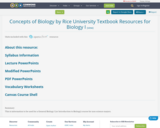
This is information to be used for a General Biology I (or Introduction to Biology) course for non-science majors.

This is information to be used for a General Biology I (or Introduction to Biology) course for non-science majors.
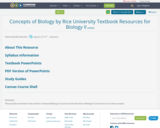
This includes materials to be used for a General Biology II course (or Introduction to Biology II course) for non-science majors.
![Fundamentals of Biology Research Project [Biology]](https://img.oercommons.org/160x134/oercommons/media/upload/materials/screenshots/materials-course-280638.png)
The goal of this initiative is to improve students' learning of the subject while developing their Inquiry and Problem-Solving competencies as well as their numeracy, written, digital and oral communication abilities. A flipped-class approach will be taken to present different topics ahead of the practical laboratory experiences. Topics will be presented with PowerPoints and/or videos posted on Blackboard. Students will be given a low stakes quiz at the beginning of each laboratory session to assess their knowledge and understanding of the posted material. A research project, introduced at the beginning of the semester, will be used as the backbone to integrate inquiry and problem-solving competencies to the laboratories. Each laboratory will explore a question/aspect outlined in the research project; students will be expected to work in pre-assigned groups and present individual written outputs, data, and analysis at the end of each laboratory session. Students will be expected to compile their results obtained during the semester, and make a digital/oral presentation at the end of the term. Students will collect background information and complete four written assignments; students will receive feedback on these assignments to allow for improvements and successful completion of the final presentations. Each individual student will also be required to write three laboratory reports. Collaborative work with group members will be essential for successful learning using an Inquiry and problem solving approach, although written reports will be marked individually, per the guidelines given in the assignments. The syllabus for the lecture component of these sections is identical to the syllabus of the standard versions of this course; the grading procedures for the laboratory component of the course are modified as described in the grading policy below.
LaGuardia's Core Competencies and Communication Abilities
Main Course Learning Objectives:
This course is an integrated two-semester laboratory-based sequence, stressing major concepts of biology designed to assist the student in relating these concepts to the environment. The scientific method of thinking and the experimental approach will be stressed. Among the topics studied are: SCB201 Cellular and molecular basis of life, heredity, and the evolution of life.

this was a flipped classroom assignment for a Biology class. It has a few starter questions and a video to watch. The students will watch the video and take Cornell Style notes.

The purpose of this assignment is to educate and engage students in understanding the immune system's role in maintaining health and to apply this knowledge by designing a scientifically informed recipe card. This card will feature an immune-boosting recipe with carefully selected ingredients backed by immunological research, with the aim of promoting a deeper understanding of the connection between nutrition, immunity, and overall well-being.
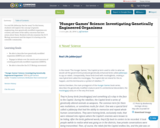
Is a real life Jabberjay that far away? In this lesson, students will explore the concept of genetic engineering, how genetically modified organisms are created, and some of the safety concerns that have arisen about them. Students will also examine the D.I.Y. Biology movement and the impact it is having on the scientific community.
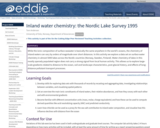
While the ionic composition of surface seawater is basically the same anywhere in the world's oceans, the chemistry of inland waters can vary by orders of magnitude over short distances. In this activity we explore a data set on surface water chemistry in almost 5000 lakes across the Nordic countries (Norway, Sweden, Finland). Water chemistry of lakes in this mostly sparsely populated region does not carry a strong signal from local human activity. This allows us to explore large-scale gradients related to distance to the ocean, soil and landscape characteristics, post-glacial history, and effects of long-distance pollutant transport processes.
(Note: this resource was added to OER Commons as part of a batch upload of over 2,200 records. If you notice an issue with the quality of the metadata, please let us know by using the 'report' button and we will flag it for consideration.)

Explains what a growing plant needs to stay healthy and what happens when a plant is lacking a necessary factor. Includes group activity, individual activity, and homework.
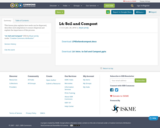
This lesson plan explains how seeds can be dispersed, describes seed adaptations to ensure dispersal and explain the importance of this process.
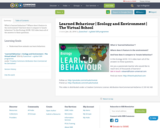
What is 'learned behaviour'? Where does it feature in the environment? And how does it compare to 'innate behaviour? In this Ecology GCSE / K12 video learn all of the answers to these questions.

Explains what a growing plant needs to stay healthy and what happens when a plant is lacking a necessary factor. Includes group activity, individual activity, and homework.
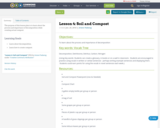
The purpose of this lesson plan is to learn about the process and importance of decomposition while creating actual compost.
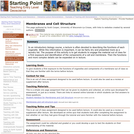
A one page assignment that uses online tutorials to give students a first exposure to the components of a cell and membrane.
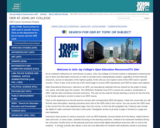
This website features many of the OER conversion projects completed at John Jay College over the past few years. Class conversions using the Blackboard platform are not represented because of the BB firewall. These are not the actual LibGuides, but content from the LibGuides, using the LibGuide platform for access. The entire website is public.
The left navigation panel displays the academic departments with the overview and objective of the department. Also, navigation to the specific departmental classes, with corresponding OER content, are found at the bottom of the academic department pages. You can also directly navigate to the specific converted class, by clicking on the course title under the department tab. When clicking on a specific class (e.g. Science 110), the link takes you to the course description, learning outcomes of the course and a link to the OER content for the specific course. The OER content features creative commons OER Textbooks, vetted open Internet sites, academic journal articles and library owned streaming video, requiring a login to the John Jay Library. Each academic department features a link to "Discussion and Comments". In addition all pages have navigation arrows to previous pages and next pages. On many of the OER content pages, the class calendar by week is featured with links to the reading assignments. In addition to the specific OER content by class, there is a link at the top of the main page to access generic OER by subject and/or topic.

A video that makes the unspoken assumptions that we use in pedigree analysis explicit through a skit of two students solving a challenging pedigree question over videoconference. The students discuss certain pedigree assumptions which are often not mentioned in other pedigree teaching materials, even though they can be important to solving complex problems. The students recognize that not all assumptions are always applicable and sometimes we need to reconsider which assumptions to use.Includes two videos: a version without subtitles and a version with subtitles
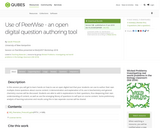
A presentation given at the BioQUEST Wicked Problems Workshop Summer 2018
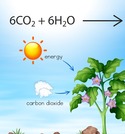
Photosythesis and Cellular Respiration interactive powerpoint.
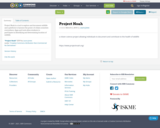
Project Noah is a tool to explore and document wildlife and a platform to harness the power of citizen scientists everywhere. Apps and tools allow students to participate in identifying and determining location of wildlife.

There is a description of the lesson that includes learning outcomes. This activity includes instructor guides, learning outcomes, student handouts, graphic organizers, and answer keys. There are two worksheets, one targeted to math students and the other targeted to biology/science students. Each worksheet is complemented with corresponding answer keys for faculty. There is background information, links to additional/supplemental information, teaching tips and a breakdown of the vocabulary differences between the math and biology classroom provided in the answer key handouts. Also, a link is provided to an original paper (Journal of Bacteriology, 1935) where bacterial growth rates were determined experimentally.

Size, Scales, and Specialization was developed as part of an effort by the Quantitative Biology at Community Colleges group to provide materials that incorporate mathematical concepts into biology courses. The activity uses published estimates of cell type numbers in the human body along with size, density and weight as a lens to have students calculate ratios, explore exponents, and better understand how the various cell types contribute to an average human's total weight and size. The activity is applicable for majors and non-majors biology courses, and maps to Chapter 4 of the OpenStax Biology 2e textbook. This activity could also be used in a mathematics course as a biologically relevant example.
The activity contains a pre-assessment to gauge student understanding of the material and provides an opportunity for students to predict the number of various cell types, as well as the mass of various cell types, in the human body. This prediction activity is followed with a guided approach to calculating these values. After guiding the students in this activity, students will then have a chance to practice the activity on a new set of cell data provided.
After completing this module students should be able to:
- Compare and contrast the structure and function of different cell types.
-- List the largest and the smallest cells in the body based on number.
-- List the largest and the smallest cells in the body based on mass.
- Describe the advantages of specialization in eukaryotic cells.
-- Give examples of how specialization in cell types affects cell size (volume) and shape.
- Perform measurements and conversions using the metric system.
-- Measure the scale of cell size variation in the human body
-- Calculate the relative proportions of cell types in the human body by mass and frequency